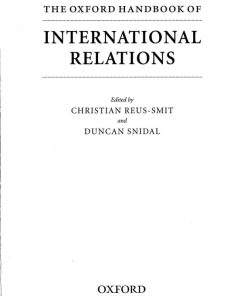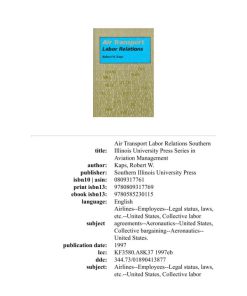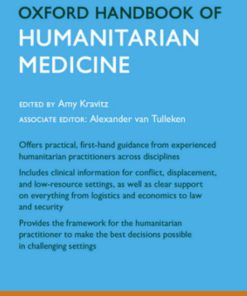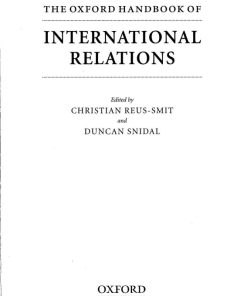The Oxford Handbook of Peaceful Change in International Relations 1st edition by Oxford University Press 0190097388 9780190097387
$50.00 Original price was: $50.00.$25.00Current price is: $25.00.
Authors:Paul, T.V. (Editor); Larson, Deborah Welch (Editor); Trinkunas, Harold A. (Editor); Wivel, Anders (Editor); Emmers, Ralf (Editor) , Series:International Relation [5] , Author sort:Paul, T.V. (Editor) & Larson, Deborah Welch (Editor) & Trinkunas, Harold A. (Editor) & Wivel, Anders (Editor) & Emmers, Ralf (Editor) , Languages:Languages:eng , Published:Published:Jan 2022 , Publisher:Oxford University Press,
The Oxford Handbook of Peaceful Change in International Relations 1st edition by Oxford University Press – Ebook PDF Instant Download/Delivery.9780190097387,0190097388
Full download The Oxford Handbook of Peaceful Change in International Relations 1st edition after payment
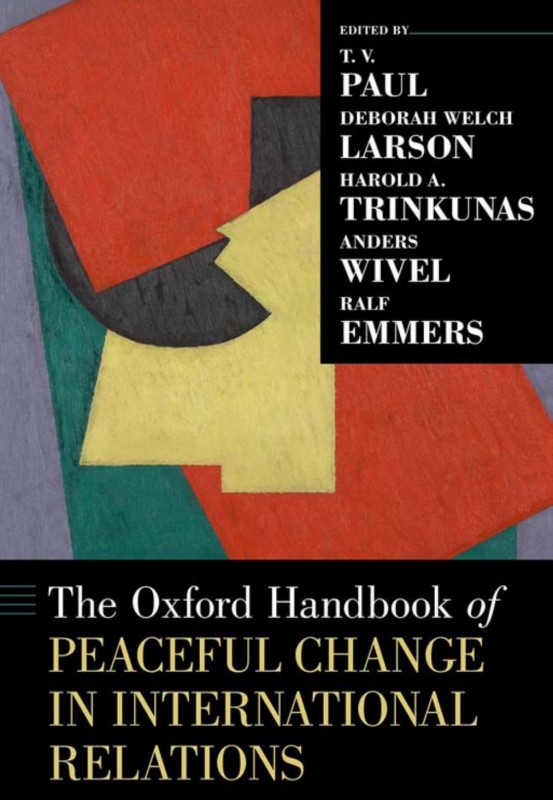
Product details:
ISBN 10:0190097388
ISBN 13:9780190097387
Author:Oxford University Press
The discipline of international relations offers much insight into why violent power transitions occur, yet there have been few substantive examinations of why and how peaceful changes happen in world politics. This work is the first comprehensive treatment of that subject. The Oxford Handbook of Peaceful Change in International Relations provides a thorough examination of research on the problem of change in the international arena and the reasons why change happens peacefully at times, and at others, violently. It contains over forty chapters, which examine the historical, theoretical, global, regional, and national foreign-policy dimensions of peaceful change. As the world enters a new round of power transition conflict, involving a rapidly rising China and a relatively declining United States, this Handbook provides a necessary resource for decisionmakers and scholars engaged in this vital area of research.
The Oxford Handbook of Peaceful Change in International Relations 1st Table of contents:
Part I Introduction
1. The Study of Peaceful Change in World Politics
Defining Peaceful Change
The Study of Peaceful Change in Historical Perspective
Theoretical Perspectives and Their Challenges
Great Powers, Rising Powers, and Peaceful Change
Peaceful Change in the Regions
The Chapters
Part II Historical Perspectives
2. Peaceful Change: The Interwar Era and the Disciplinary Context
The Institutional Context: The League and Its Commissions
Preparing for Paris: Introducing Peaceful Change
Discussing Peaceful Change I: Tensions in the Discourse
Discussing Peaceful Change II: Assumptions of Scholarship and Science
Conclusions
3. Peaceful Change after the World Wars
Geopolitical and Technological Developments: From Peaceful Change to Peaceful Coexistence
Peaceful Change and the Postwar Politics of Appeasement and Containment
From Colonial to Anticolonial Peaceful Change
Disciplinary and Institutional Changes: International Politics and Law
Intellectual Developments: A Swing from Idealist to Realist Peaceful Change?
Peaceful Change in Functionalist and Neofunctionalist IR
Conclusion
4. Peaceful Change: The Post–Cold War Evolution
Unipolarity and Peaceful Change
US Liberal Hegemony and Peaceful Change
Globalization and Peaceful Change
Conclusions
Part III Theoretical Perspectives
5. Realism and Peaceful Change: A Structural and Neoclassical Realist First-Cut
What Is Peaceful Change?
Realism_ Review and Reprise
Prospects for Type I Peaceful Change: Arguments and Illustrations
Type II Change: Arguments and Illustrations
Conclusion: Toward a Research Agenda
6. Liberalism and Peaceful Change
Liberal Ideas about International Order and Peace
Implementing Liberal Ideas in International Politics
The Crisis of Liberalism? Contemporary Challenges to the Liberal Order
7. International Institutions and Peaceful Change
How Institutions Promote Peaceful Change
How Institutions Inhibit Peaceful Change
Conclusion
8. Economic Interdependence, Globalization, and Peaceful Change
Economic Interdependence Enhances the Prospects for Peaceful Change
Alternatives to the Liberal Approach: Economic Interdependence Enhances the Prospects for Interstate Conflict
Conceptualizing and Measuring the Independent Variable
The Dependent Variable
Interdependence and Peaceful Change in an Era of Globalization
Conclusion
9. Constructivism and Peaceful Change
The Origins of Constructivism_ Peaceful Change
Open to Change: The Power of Collective Meanings
Peaceful Change: Concepts and Mechanisms
Biases: Are All Changes Peaceful?
Conclusion
Acknowledgments
10. Peaceful Change in English School Theory: Great Power Management and Regional Order
The Men (and One Woman) of 1937
Order and Justice after Manning
The Club of Powers
Regional Rules of the Game
Conclusion
11. Critical Theories and Change in International Relations
What Are “Critical IR Theories”?
Violence as Ubiquitous, Commitment to Peace as a Handicap
The Need for Fundamental Change, and Where It Might Come From
Conclusion
12. Gender and Peaceful Change
Gender, War, and Conflict
Gender, Feminism, and Peaceful Change
Policy Formulations on Gender and Peaceful Change
Conclusion
13. Civilization, Religion, AND Peaceful and Non-Peaceful Change in Asia
Clash of Civilizations in Plural and Pluralist Asia
Canonical Ambiguity, and Peaceful and Violent Change
Change Agents, Institutional Weaknesses, and Peaceful and Violent Change
Islam in Afghanistan and Indonesia
Hinduism, and Peaceful and Violent Change in India
Buddhism, and Peaceful and Violent Change in Sri Lanka, Myanmar, and Tibet
Confucianism, Chinese Civilization, and Peaceful and Violent Change in China
Conclusion
14. Evolutionary Theorization of Peaceful International Changes
Why an Evolutionary Approach toward Human Society?
Evolution: From Biological to Social
Evolutionary Theorization of International Relations: From Anti/Pseudo to Genuine
Peaceful International Changes: Five Issue Domains
Conclusions
Part IV The Sources of Change
15. International Law and Peaceful Change
Understanding International Law
The Laws of War and Peaceful Change
International Law and Systemic Change: The Creation of New States
Conclusion
16. Nuclear Weapons and Peaceful Change
Nuclear Deterrence
Nuclear Arms Control
Nuclear Nonproliferation
Nuclear Nonuse
Nuclear Disarmament
Key Linkages and Conflicts
Conclusions
17. The Political Economy of Peaceful Change
Economic Interdependence and Peaceful Change
Economic Statecraft
Conclusions
18. Climate Change, Collective Action, and Peaceful Change
Climate Change and Insecurities
Collective Action Toward Limiting Climate Change Threats
Climate Change Bringing Peaceful Change by Promoting Global Partnership
19. Democracy, Global Governance, and Peaceful Change
The Debate in Historical Perspective
National Democracy and Peaceful Change
Democratic Global Governance and Peaceful Change
Transnational Democracy and Peaceful Change
Future Prospects
20. Status Quest and Peaceful Change
Status Quest and International Conflict
Status Quest and Peaceful Change
Status Quest and Minimalist Peaceful Change
Status Quest and Maximalist Peaceful Change
Conclusion
21. Science, Technology, and Peaceful Change in World Politics
S/T, Peaceful Change, and Security
S/T, Peaceful Change, and International Organization
S/T, Peaceful Change, and the Global Economy
Conceptualizing Peaceful Change in World Politics
Meeting the Challenges of Climate Change and the Fourth Technological Revolution
Author’s Note
22. Transnational Social Movements and Peaceful Change
Conveyor Belts, Emancipation, and Peace
The Divide of Civil Society
Revolutions, Change, and Violence
Conclusion
Part V Great Powers, Rising Powers, and Peaceful Change
23. Peaceful Change in US Foreign Policy
Anglo-American Leadership Transition
Wilsonian Internationalism
Post–World War II Settlement
Nixon-Kissinger “Structure of Peace”
Post–Cold War Multilateralism
Conclusion
24. China’s Peaceful Rise: From Narrative to Practice
The Origin of China’s “Peaceful Rise” Strategy
Why “Peaceful Rise”?
“Peaceful Rise” in Practice
Conclusion: China’s Peaceful Rise in the Future?
25. Russia and Peaceful Change: From Gorbachev to Putin
Gorbachev’s Revolutionary New Thinking
Yeltsin: From Domestic Transformation and Western Integration to Anti-Hegemonic (Soft) Balancing
Putin: From Pragmatic Partnership to Reactionary Neorevisionism
Conclusions
26. Germany and Peaceful Change
Pursuing Peaceful Foreign Policy Change
Pursuing Peaceful Regional Change
Pursuing Peaceful Global Change
Conclusion
27. Japan and Peaceful Change in the International System: The Persistent Peace Nation
The Genesis of Japan as a “Peace Nation”
The Peace Nation in Practice: 1960 to 2012
The Peace Nation in the Dragon’s Maw
Conclusion
28. India and Peaceful Change
Decolonization
Panchsheel
Nuclear Disarmament
“Look/Act East” Strategy
The Indo-Pacific
Conclusion
29. South Africa and the Idea of Peaceful Change
Vocabulary
Placeholder
Soft Power
African Player
The Struggle Continues
30. Indonesia’s ContributionS to Peaceful Change in International Affairs
From Revolutionary Politics to Developmental Peace
Indonesia’s Role as a Middle Power
Promoting Moderate Islam and Democracy as a New Foreign Policy Agenda
Conclusion
Part VI Regional Perspectives
31. Peaceful Change in Western Europe: From Balance of Power to Political Community?
From the Epicenter of War to Pax Europaea
Hobbesian Europe: Containing Enmity in International Anarchy
Lockean Europe: The Rational Response to Rivalry
Kantian Europe and Beyond: Widening and Deepening the Western European Security Community
Conclusions
32. Origins and Evolution of the North American Stable Peace
The North American “Zone of War”
The North American Zone of Peace
Conclusion: What’s Mexico Got to Do with It?
33. Latin America’s Evolving Contribution to Peaceful Change in the International System: A Stony Road
Realism, Neorealism, and Latin America
Liberalism, Liberal Institutionalism, and the Americas
Constructivist Approaches to Peaceful Change in Latin America
The Role of Systemic and Subsystemic Factors on Regional Transformation
Latin America’s Past and Future Trajectories in the Domains of Peace and Order
34. Peaceful Change in Africa
Liberty: Peaceful Change as Establishing Horizontal Relations with the World
Unity: Peaceful Change as Standing Together
Development: Peaceful Change as Progressing Economically
Pacific Settlement of Disputes: Managing Conflicts by Agreement
Democracy: Peaceful Change as Rule by the People
Challenges: The Elusiveness of Peaceful Change
Conclusion
35. Peaceful Change in Southeast Asia: The Historical and Institutional Bases
Historical Perspectives: From Building a “Zone of Peace” to Navigating Great Power Competition
Theoretical Perspectives
Dealing with Change
Conclusion
36. South Asia’s Limited Progress toward Peaceful Change
Regional Interstate Dynamics
Postcolonial South Asia: The Cold War Era
The Post–Cold War Era: Changing Patterns
Institutions and Peaceful Change in South Asia
Conclusion
37. Peaceful Change in Northeast Asia: Maintaining the “Minimal Peace”
Transitions of Northeast Asian Order
Minimal Peace in Northeast Asia
Fraying of Minimal Peace in Northeast Asia?
Conclusion
38. The Middle East and Peaceful Change
Great Powers, Global Structures, and Regional Peaceful Change
The Regional Level: Ideas, Institutions, and the Challenges to Peaceful Change
The Interactive/Bilateral Level: Peaceful Territorial Change in the Arab-Israeli Conflict
Domestic Political Changes and Regional Peaceful Change
Conclusions
39. Explaining Peaceful Change in Central and Eastern Europe
Realist Explanation for Peaceful Change and Its Limitations
The Theoretical Framework: The State-to-Nation Balance
Peaceful Change in Czechoslovakia versus Civil War in the Former Yugoslavia
Great Powers’ Influence and the Conflict-Peace Continuum in Central Europe, Eastern Europe, and the Baltic States
Post-Soviet States
Great Power Intervention in the Former Yugoslavia
Conclusion
40. Central Asia: A Decolonial Perspective on Peaceful Change
Post-Soviet Peaceful Change and the Untold Agency of Central Asian States
Illiberal Peace? A Local and Global Transition
Postcolonial Change and the Decolonization of IR in Central Asia
Toward a Comparative and Global Approach to Change in Central Asia
Part VII Conclusions
41. A Research Agenda for the Study of Peaceful Change in World Politics
Historical Perspectives
Theoretical Perspectives
Sources and Mechanisms of Change
Great Powers and Rising Powers as Agents of Peaceful Change
Regional Orders and Peaceful Change
People also search for The Oxford Handbook of Peaceful Change in International Relations 1st :
the oxford handbook of happiness
the oxford handbook of religion conflict and peacebuilding
the oxford handbook of peace history
the oxford handbook of peaceful change in international relations
the oxford handbook of confucianism
You may also like…
eBook PDF
Oxford Handbook of Cardiac Nursing 3rd Edition by Kate Olson ISBN 9780192568588 0192568582
eBook PDF
Oxford Handbook of Humanitarian Medicine 1st edition by Amy Kravitz ISBN 0199565279 978-0199565276



